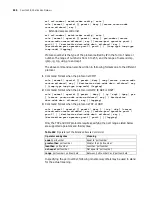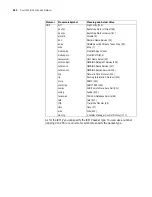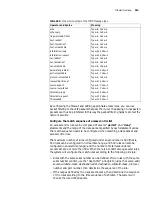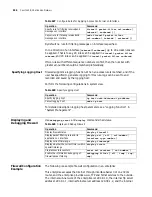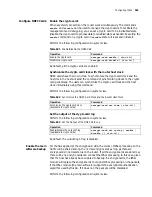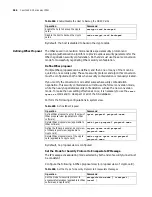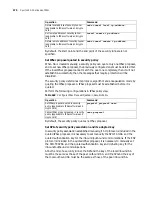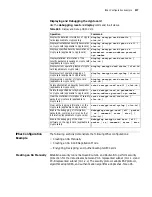
562
C
HAPTER
40: C
ONFIGURING
IPS
EC
state by polling. Thus, crypto cards can synchronously process user data, which
improves the speed of data encryption and decryption.
For the IPSec applied at the crypto card side, the crypto cards will be unable to
implement the IPSec processing if all the crypto cards on the router are in
abnormal state. In this case, given that the host has been enabled to backup the
crypto cards, the IPSec module of the operating system will replace the crypto
cards to implement the IPSec processing, if the IPSec module supports the
encryption/authentication algorithm used by the crypto cards. Thus, the software
IPSec module fulfills the backup of crypto cards.
The processing mechanism of the crypto cards and that of the software IPSec
module is almost the same. The only difference is that the former implements the
encryption/decryption processing through the software and the latter through the
the main operating system.
IPSec Message
Processing
IPSec can process messages as follows (with AH protocol as an example):
■
Add authentication header to messages: IP messages sent by the module block
from IPSec queue are read, and an AH header is added according to the
configured protocol mode (transport or tunnel mode), then forward it by IP
layer.
■
Cancel the authentication header after messages are authenticated: The IP
message received at the IP layer is analyzed as a local host address with
protocol number 51, then the corresponding protocol switch table item is
searched and the corresponding input processing function is called. This
processing function authenticates the message to make a comparison with the
original authentication value. If the values are the same, the added AH is
canceled, and the original IP message is restored. Then IP input flow is recalled
for processing. Otherwise, this message is discarded.
IPSec Related Terms
The following terms are important to an understanding of IPSec:
■
Data stream:
A combination of a group of traffic, which is prescribed by
source address/mask, destination address/mask, encapsulation upper-level
protocol number of IP message, source port number, destination port number,
etc. Generally, a data stream is defined by an access list, and all messages
permitted by access list are called a data stream logically. A data stream can be
a TCP connection between the endpoints, or all the data stream transferred
between two subnets. IPSec can implement different security protections for
different data streams. For example, it can use different security protocols for
different data flow, algorithm and ciphering.
■
Security policy:
The policy, which is configured manually by the user to define
what security measure to take for what data stream. The data stream is defined
by configuring multiple rules in an access list, and in security policy this access
list is quoted to determine to protect the data flow.
Name
and
Sequence
number
define a security policy uniquely.
■
Security policy group:
The set of the security policies with the same name. A
security policy group can be applied or cancelled on an interface, applying
multiple security polices in the same security policy group to this interface, to
implement different security protection for different data streams. The security
Summary of Contents for 3036
Page 1: ...http www 3com com 3Com Router Configuration Guide Published March 2004 Part No 10014299 ...
Page 4: ...VPN 615 RELIABILITY 665 QOS 681 DIAL UP 721 ...
Page 6: ...2 ABOUT THIS GUIDE ...
Page 7: ...I GETTING STARTED Chapter 1 3Com Router Introduction Chapter 2 3Com Router User Interface ...
Page 8: ...4 ...
Page 16: ...12 CHAPTER 1 3COM ROUTER INTRODUCTION ...
Page 34: ...30 ...
Page 60: ...56 CHAPTER 3 SYSTEM MANAGEMENT ...
Page 98: ...94 CHAPTER 6 DISPLAY AND DEBUGGING TOOLS ...
Page 110: ...106 ...
Page 114: ...110 CHAPTER 8 INTERFACE CONFIGURATION OVERVIEW ...
Page 158: ...154 CHAPTER 10 CONFIGURING WAN INTERFACE ...
Page 168: ...164 ...
Page 188: ...184 CHAPTER 13 CONFIGURING PPPOE CLIENT ...
Page 192: ...188 CHAPTER 14 CONFIGURING SLIP Router ip route static 0 0 0 0 0 0 0 0 10 110 0 1 ...
Page 248: ...244 CHAPTER 16 CONFIGURING LAPB AND X 25 ...
Page 320: ...316 ...
Page 330: ...326 CHAPTER 20 CONFIGURING IP ADDRESS ...
Page 362: ...358 CHAPTER 21 CONFIGURING IP APPLICATION ...
Page 374: ...370 CHAPTER 23 CONFIGURING IP COUNT ...
Page 406: ...402 CHAPTER 25 CONFIGURING DLSW ...
Page 408: ...404 ...
Page 452: ...448 CHAPTER 29 CONFIGURING OSPF ...
Page 482: ...478 CHAPTER 30 CONFIGURING BGP ...
Page 494: ...490 CHAPTER 31 CONFIGURING IP ROUTING POLICY ...
Page 502: ...498 ...
Page 508: ...504 CHAPTER 33 IP MULTICAST ...
Page 514: ...510 CHAPTER 34 CONFIGURING IGMP ...
Page 526: ...522 CHAPTER 36 CONFIGURING PIM SM ...
Page 528: ...524 ...
Page 532: ...528 CHAPTER 37 CONFIGURING TERMINAL ACCESS SECURITY ...
Page 550: ...546 CHAPTER 38 CONFIGURING AAA AND RADIUS PROTOCOL ...
Page 590: ...586 CHAPTER 40 CONFIGURING IPSEC ...
Page 599: ...IX VPN Chapter 42 Configuring VPN Chapter 43 Configuring L2TP Chapter 44 Configuring GRE ...
Page 600: ...596 ...
Page 638: ...634 CHAPTER 43 CONFIGURING L2TP ...
Page 649: ...X RELIABILITY Chapter 45 Configuring a Standby Center Chapter 46 Configuring VRRP ...
Page 650: ...646 ...
Page 666: ...662 ...
Page 670: ...666 CHAPTER 47 QOS OVERVIEW ...
Page 700: ...696 CHAPTER 49 CONGESTION MANAGEMENT ...
Page 706: ...702 CHAPTER 50 CONGESTION AVOIDANCE ...
Page 707: ...XII DIAL UP Chapter 51 Configuring DCC Chapter 52 Configuring Modem ...
Page 708: ...704 ...
Page 762: ...758 CHAPTER 52 CONFIGURING MODEM ...



